Land Cover Mapping in Southwestern China Using the HC-MMK Approach
Abstract
:1. Introduction
2. Study Area
3. Methodology
3.1. Overall Description
3.2. Land Cover Classification System
3.3. Remote Sensing Data Collection and Mapping Units
3.4. Field Data Collection
3.5. Object-Oriented Multi-Resolution Segmentation
3.6. Hierarchical Classification Trees Construction by Decision Tree Algorithms
3.6.1. Training Sample Sets
3.6.2. Multi-Type Classification Feature Sets
3.6.3. Conceptual Hierarchical Structure
3.7. Five-Step Interactive Quality Control Based on Knowledge
3.7.1. Step One: Interactive Quality Control Based on Geographical Rules
3.7.2. Step Two: Interactive Quality Control Based on Available Thematic Maps
3.7.3. Step Three: Spatial Consistency Verification
3.7.4. Step Four: Interactive Quality Control with Field Verification Points
3.7.5. Step Five: Interactive Quality Control with Statistics Reports
4. Results
4.1. Hierarchical Decision Tree
4.1.1. The Decision Tree for Distinguishing Vegetation and Non-Vegetation
4.1.2. The Decision Tree for Vegetation Division
4.1.3. The Decision Tree for Forests Division
4.2. Effectiveness of Interactive Quality Control
4.3. The CLC-SW2010 Product and Product Accuracy
5. Discussions
5.1. Comparison with Existing 30 m-Resolution Land Cover Products
5.2. The Contribution of Each Component in the HC-MMK Approach
5.2.1. The Multi-Source and Multi-Temporal Data
5.2.2. Knowledge
5.2.3. Hierarchical Classification
5.2.4. Quality Control
5.3. The Merits and Limitations of the Current Work
6. Conclusions
Acknowledgments
Author Contributions
Conflicts of Interest
References
- Yang, J.; Gong, P.; Fu, R.; Zhang, M.H.; Chen, J.M.; Liang, S.L.; Xu, B.; Shi, J.C.; Dickinson, R. The role of satellite remote sensing in climate change studies. Nat. Clim. Chang. 2013, 3, 875–883. [Google Scholar] [CrossRef]
- Shupeng, C.; van Genderen, J. Digital Earth in support of global change research. Int. J. Digit. Earth 2008, 1, 43–65. [Google Scholar] [CrossRef]
- Gross, J.E.; Goetz, S.J.; Cihlar, J. Application of remote sensing to parks and protected area monitoring: Introduction to the special issue. Remote Sens. Environ. 2009, 113, 1343–1345. [Google Scholar] [CrossRef]
- Wiens, J.; Sutter, R.; Anderson, M.; Blanchard, J.; Barnett, A.; Aguilar-Amuchastegui, N.; Avery, C.; Laine, S. Selecting and conserving lands for biodiversity: The role of remote sensing. Remote Sens. Environ. 2009, 113, 1370–1381. [Google Scholar] [CrossRef]
- Gong, P.; Wang, J.; Yu, L.; Zhao, Y.C.; Zhao, Y.Y.; Liang, L.; Niu, Z.G.; Huang, X.M.; Fu, H.H.; Liu, S.; et al. Finer resolution observation and monitoring of global land cover: First mapping results with Landsat TM and ETM+ data. Int. J. Remote Sens. 2013, 34, 2607–2654. [Google Scholar] [CrossRef]
- Hansen, M.C.; Potapov, P.V.; Moore, R.; Hancher, M.; Turubanova, S.A.; Tyukavina, A.; Thau, D.; Stehman, S.V.; Goetz, S.J.; Loveland, T.R.; et al. High-resolution global maps of 21st-century forest cover change. Science 2013, 342, 850–853. [Google Scholar] [CrossRef] [PubMed]
- Loveland, T.R.; Reed, B.C.; Brown, J.F.; Ohlen, D.O.; Zhu, Z.; Yang, L.; Merchant, J.W. Development of a global land cover characteristics database and IGBP DISCover from 1 km AVHRR data. Int. J. Remote Sens. 2000, 21, 1303–1330. [Google Scholar] [CrossRef]
- Friedl, M.A.; Sulla-Menashe, D.; Tan, B.; Schneider, A.; Ramankutty, N.; Sibley, A.; Huang, X.M. MODIS collection 5 global land cover: Algorithm refinements and characterization of new datasets. Remote Sens. Environ. 2010, 114, 168–182. [Google Scholar] [CrossRef]
- Arino, O.; Bicheron, P.; Achard, F.; Latham, J.; Witt, R.; Weber, J.L. GlobCover the Most Detailed Portrait of Earth. Available online: https://earth.esa.int/web/guest/-/globcover-the-most-detailed-portrait-of-earth-5910 (accessed on 30 March 2016).
- Yu, L.; Wang, J.; Li, X.; Li, C.; Zhao, Y.; Gong, P. A multi-resolution global land cover dataset through multisource data aggregation. Sci. China-Earth Sci. 2014, 57, 2317–2329. [Google Scholar] [CrossRef]
- Chen, J.; Chen, J.; Liao, A.P.; Cao, X.; Chen, L.J.; Chen, X.H.; He, C.Y.; Han, G.; Peng, S.; Lu, M.; et al. Global land cover mapping at 30 m resolution: A POK-based operational approach. ISPRS J. Photogramm. Remote Sens. 2015, 103, 7–27. [Google Scholar] [CrossRef]
- Liu, J.Y. Study on national resources and environment survey and dynamic monitoring using remote sensing. J. Remote Sens. 1997, 1, 225–230. [Google Scholar]
- Liu, J.Y.; Kuang, W.H.; Zhang, Z.X.; Xu, X.L.; Qin, Y.W.; Ning, J.; Zhou, W.C.; Zhang, S.W.; Li, R.D.; Yan, C.Z.; et al. Spatiotemporal characteristics, patterns, and causes of land-use changes in China since the late 1980s. J. Geogr. Sci. 2014, 24, 195–210. [Google Scholar] [CrossRef]
- Giri, C.; Pengra, B.; Long, J.; Loveland, T.R. Next generation of global land cover characterization, mapping, and monitoring. Int. J. Appl. Earth Obs. Geoinf. 2013, 25, 30–37. [Google Scholar] [CrossRef]
- Kuenzer, C.; Leinenkugel, P.; Vollmuth, M.; Dech, S. Comparing global land-cover products-implications for geoscience applications: An investigation for the trans-boundary Mekong Basin. Int. J. Remote Sens. 2014, 35, 2752–2779. [Google Scholar] [CrossRef]
- Li, A.N.; Jiang, J.G.; Bian, J.H.; Deng, W. Combining the matter element model with the associated function of probability transformation for multi-source remote sensing data classification in mountainous regions. ISPRS J. Photogramm. Remote Sens. 2012, 67, 80–92. [Google Scholar] [CrossRef]
- Jia, K.; Liang, S.L.; Zhang, N.; Wei, X.Q.; Gu, X.F.; Zhao, X.; Yao, Y.J.; Xie, X.H. Land cover classification of finer resolution remote sensing data integrating temporal features from time series coarser resolution data. ISPRS J. Photogramm. Remote Sens. 2014, 93, 49–55. [Google Scholar] [CrossRef]
- Yu, L.; Wang, J.; Gong, P. Improving 30 m global land-cover map FROM-GLC with time series MODIS and auxiliary data sets: A segmentation-based approach. Int. J. Remote Sens. 2013, 34, 5851–5867. [Google Scholar] [CrossRef]
- Lei, G.B.; Li, A.N.; Bian, J.H.; Zhang, Z.J.; Zhang, W.; Wu, B.F. An practical method for automatically identifying the evergreen and deciduous characteristic of forests at mountainous areas: A case study in Mt.Gongga Region. Acta Ecol. Sin. 2014, 34, 7210–7221. [Google Scholar]
- Senf, C.; Pflugmacher, D.; van der Linden, S.; Hostert, P. Mapping rubber plantations and natural forests in Xishuangbanna (Southwest China) using multi-spectral phenological metrics from MODIS time series. Remote Sens. 2013, 5, 2795–2812. [Google Scholar] [CrossRef]
- Turner, W.; Rondinini, C.; Pettorelli, N.; Mora, B.; Leidner, A.K.; Szantoi, Z.; Buchanan, G.; Dech, S.; Dwyer, J.; Herold, M.; et al. Free and open-access satellite data are key to biodiversity conservation. Biol. Conserv. 2015, 182, 173–176. [Google Scholar] [CrossRef]
- Bian, J.H.; Li, A.N.; Wang, Q.F.; Huang, C.Q. Development of dense time series 30-m image products from the Chinese HJ-1A/B Constellation: A case study in Zoige Plateau, China. Remote Sens. 2015, 7, 16647–16671. [Google Scholar] [CrossRef]
- Bian, J.H.; Li, A.N.; Jin, H.A.; Lei, G.B.; Huang, C.Q.; Li, M.X. Auto-registration and orthorecification algorithm for the time series HJ-1A/B CCD images. J. Mt. Sci. 2013, 10, 754–767. [Google Scholar] [CrossRef]
- Wang, Q.; Wu, C.Q.; Li, Q.; Li, J.S. Chinese HJ-1A/B satellites and data characteristics. Sci. China Earth Sci. 2010, 53, 51–57. [Google Scholar] [CrossRef]
- Yu, Q.; Gong, P.; Clinton, N.; Biging, G.; Kelly, M.; Schirokauer, D. Object-based detailed vegetation classification with airborne high spatial resolution remote sensing imagery. Photogramm. Eng. Remote Sens. 2006, 72, 799. [Google Scholar] [CrossRef]
- Ouyang, Z.T.; Zhang, M.Q.; Xie, X.; Shen, Q.; Guo, H.Q.; Zhao, B. A comparison of pixel-based and object-oriented approaches to VHR imagery for mapping saltmarsh plants. Ecol. Inform. 2011, 6, 136–146. [Google Scholar] [CrossRef]
- Huang, C.; Davis, L.S.; Townshend, J.R.G. An assessment of support vector machines for land cover classification. Int. J. Remote Sens. 2002, 23, 725–749. [Google Scholar] [CrossRef]
- Mountrakis, G.; Im, J.; Ogole, C. Support vector machines in remote sensing: A review. ISPRS J. Photogramm. Remote Sens. 2011, 66, 247–259. [Google Scholar] [CrossRef]
- Friedl, M.A.; Brodley, C.E. Decision tree classification of land cover from remotely sensed data. Remote Sens. Environ. 1997, 61, 399–409. [Google Scholar] [CrossRef]
- Canty, M.J. Boosting a fast neural network for supervised land cover classification. Comput. Geosci. 2009, 35, 1280–1295. [Google Scholar] [CrossRef]
- Tseng, M.H.; Chen, S.J.; Hwang, G.H.; Shen, M.Y. A genetic algorithm rule-based approach for land-cover classification. ISPRS J. Photogramm. Remote Sens. 2008, 63, 202–212. [Google Scholar] [CrossRef]
- Lu, D.R.; Ding, Z.L. Climate change: Carbon budget and relevant issues. Bull. Chin. Acad. Sci. 2012, 27, 395–402. [Google Scholar]
- Ouyang, Z.Y.; Wang, Q.; Zheng, H.; Zhang, F.; Hou, P. National ecosystem survey and assessment of China (2000–2010). Bull. Chin. Acad. Sci. 2014, 29, 462–466. [Google Scholar]
- Deng, W.; Xiong, Y.L.; Zhao, J.D.; Qiu, D.L.; Zhang, Z.Q.; Wen, A.B. Enlightenment from international mountain research projects. J. Mt. Sci. 2013, 31, 377–384. [Google Scholar]
- Zhang, L.; Wu, B.F.; Li, X.S.; Xing, Q. Classification system of China land cover for carbon budget. Acta Ecol. Sin. 2014, 34, 7158–7166. [Google Scholar] [CrossRef]
- Wolfe, R.; Masek, J.; Saleous, N.; Hall, F. Ledaps: Mapping North American disturbance from the Landsat record. Int. Geosci. Remote Sens. 2004, 1, 1–4. [Google Scholar]
- Li, A.N.; Jiang, J.G.; Bian, J.H.; Lei, G.B.; Huang, C.Q. Experiment and accuracy analysis of automated registration and orthorectification for Landsat-like images based on AROP. Remote Sens. Technol. Appl. 2012, 27, 23–32. [Google Scholar]
- Nan, X.; Li, A.N.; Bian, J.H.; Zhang, Z.J. Comparison of the accuracy between SRTM and ASTER GDEM over typical mountain area: A case study in the Eastern Qinghai-Tibetan Plateau. J. Geo-Inf. Sci. 2015, 17, 91–98. [Google Scholar]
- Hayakawa, Y.S.; Oguchi, T.; Lin, Z. Comparison of new and existing global digital elevation models: ASTER G-DEM and SRTM-3. Geophys. Res. Lett. 2008, 35, 36–44. [Google Scholar] [CrossRef]
- Hou, Z.; Xu, Q.; Nuutinen, T.; Tokola, T. Extraction of remote sensing-based forest management units in tropical forests. Remote Sens. Environ. 2013, 130, 1–10. [Google Scholar] [CrossRef]
- Johnson, B.; Xie, Z. Unsupervised image segmentation evaluation and refinement using a multi-scale approach. ISPRS J. Photogramm. Remote Sens. 2011, 66, 473–483. [Google Scholar] [CrossRef]
- Trimble. Ecognition Developer User Guide; Version 8.7; Definiens: Munich, Germany, 2011. [Google Scholar]
- Goward, S.N.; Markham, B.; Dye, D.G.; Dulaney, W.; Yang, J. Normalized difference vegetation index measurements from the advanced very high resolution radiometer. Remote Sens. Environ. 1991, 35, 257–277. [Google Scholar] [CrossRef]
- Gao, B.C. NDWI—A normalized difference water index for remote sensing of vegetation liquid water from space. Remote Sens. Environ. 1996, 58, 257–266. [Google Scholar] [CrossRef]
- Zha, Y.; Gao, J.; Ni, S. Use of normalized difference built-up index in automatically mapping urban areas from TM imagery. Int. J. Remote Sens. 2003, 24, 583–594. [Google Scholar] [CrossRef]
- Xu, E.Q.; Zhang, H.Q.; Li, M.X. Object-based mapping of karst rocky desertification using a support vector machine. Land Degrad. Dev. 2015, 26, 158–167. [Google Scholar] [CrossRef]
- Townshend, J.; Justice, C.; Li, W.; Gurney, C.; Mcmanus, J. Global land cover classification by remote-sensing—Present capabilities and future possibilities. Remote Sens. Environ. 1991, 35, 243–255. [Google Scholar] [CrossRef]
- Homer, C.; Dewitz, J.; Yang, L.M.; Jin, S.; Danielson, P.; Xian, G.; Coulston, J.; Herold, N.; Wickham, J.; Megown, K. Completion of the 2011 national land cover database for the Conterminous United States—representing a decade of land cover change information. Photogramm. Eng. Remote Sens. 2015, 81, 345–354. [Google Scholar]
- Dorren, L.K.A.; Maier, B.; Seijmonsbergen, A.C. Improved Landsat-based forest mapping in steep mountainous terrain using object-based classification. Forest Ecol. Manag. 2003, 183, 31–46. [Google Scholar] [CrossRef]
- Wang, J.; Zhao, Y.Y.; Li, C.C.; Yu, L.; Liu, D.S.; Gong, P. Mapping global land cover in 2001 and 2010 with spatial-temporal consistency at 250 m resolution. ISPRS J. Photogramm. Remote Sens. 2015, 103, 38–47. [Google Scholar] [CrossRef]
- Mosleh, M.K.; Hassan, Q.K. Development of a remote sensing-based “boro” rice mapping system. Remote Sens. 2014, 6, 1938–1953. [Google Scholar] [CrossRef]
- Laliberte, A.S.; Fredrickson, E.L.; Rango, A. Combining decision trees with hierarchical object-oriented image analysis for mapping arid rangelands. Photogramm. Eng. Remote Sens. 2007, 73, 197–207. [Google Scholar] [CrossRef]
- Sulla-Menashe, D.; Friedl, M.A.; Krankina, O.N.; Baccini, A.; Woodcock, C.E.; Sibley, A.; Sun, G.Q.; Kharuk, V.; Elsakov, V. Hierarchical mapping of Northern Eurasian land cover using MODIS data. Remote Sens. Environ. 2011, 115, 392–403. [Google Scholar] [CrossRef]
- Gholoobi, M.; Kumar, L. Using object-based hierarchical classification to extract land use land cover classes from high-resolution satellite imagery in a complex urban area. J. Appl. Remote Sens. 2015, 9, 096052. [Google Scholar] [CrossRef]
- Vanselow, K.A.; Samimi, C. Predictive mapping of dwarf shrub vegetation in an arid high mountain ecosystem using remote sensing and random forests. Remote Sens. 2014, 6, 6709–6726. [Google Scholar] [CrossRef]
- Hansen, M.C.; Loveland, T.R. A review of large area monitoring of land cover change using Landsat data. Remote Sens. Environ. 2012, 122, 66–74. [Google Scholar] [CrossRef]
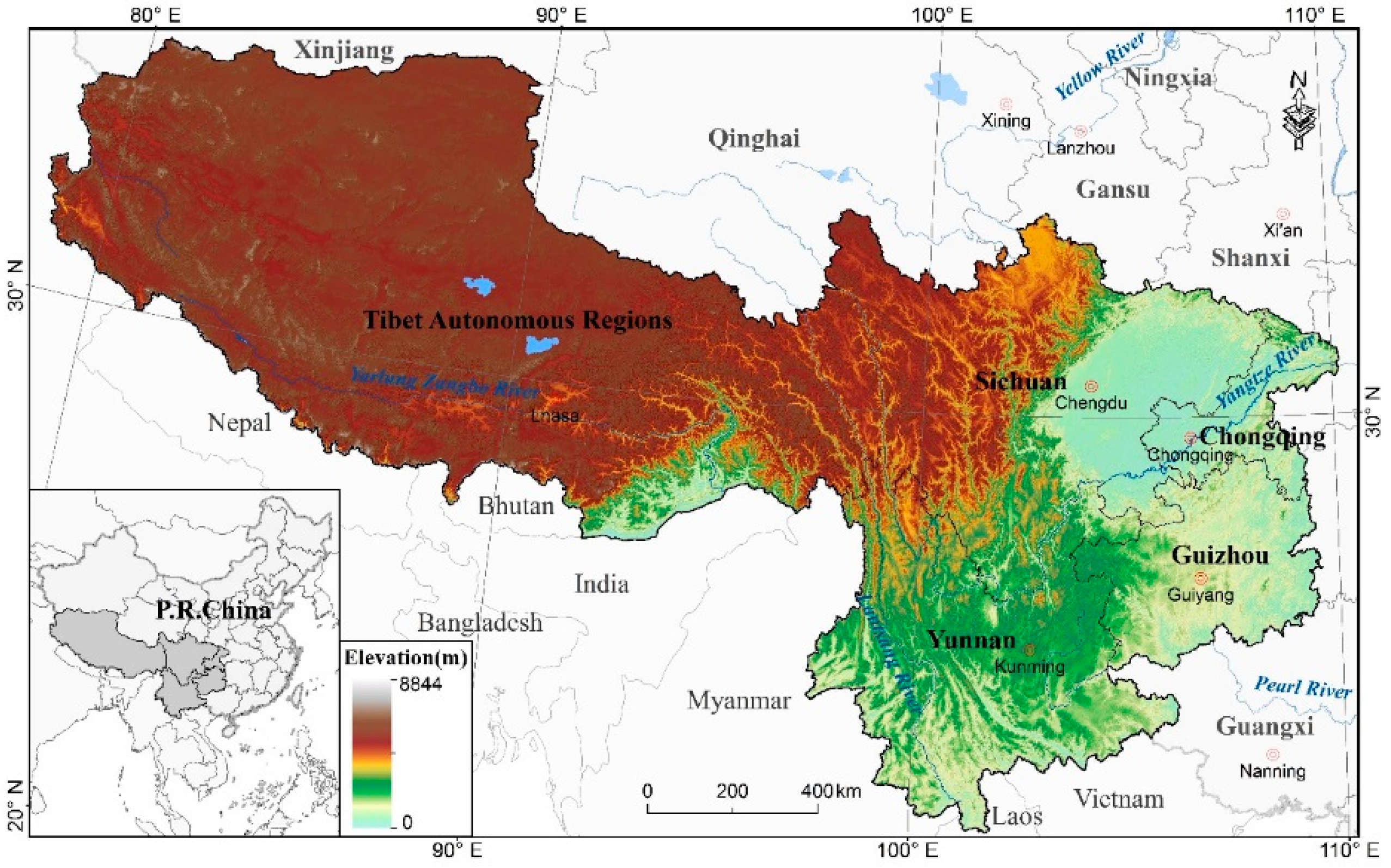
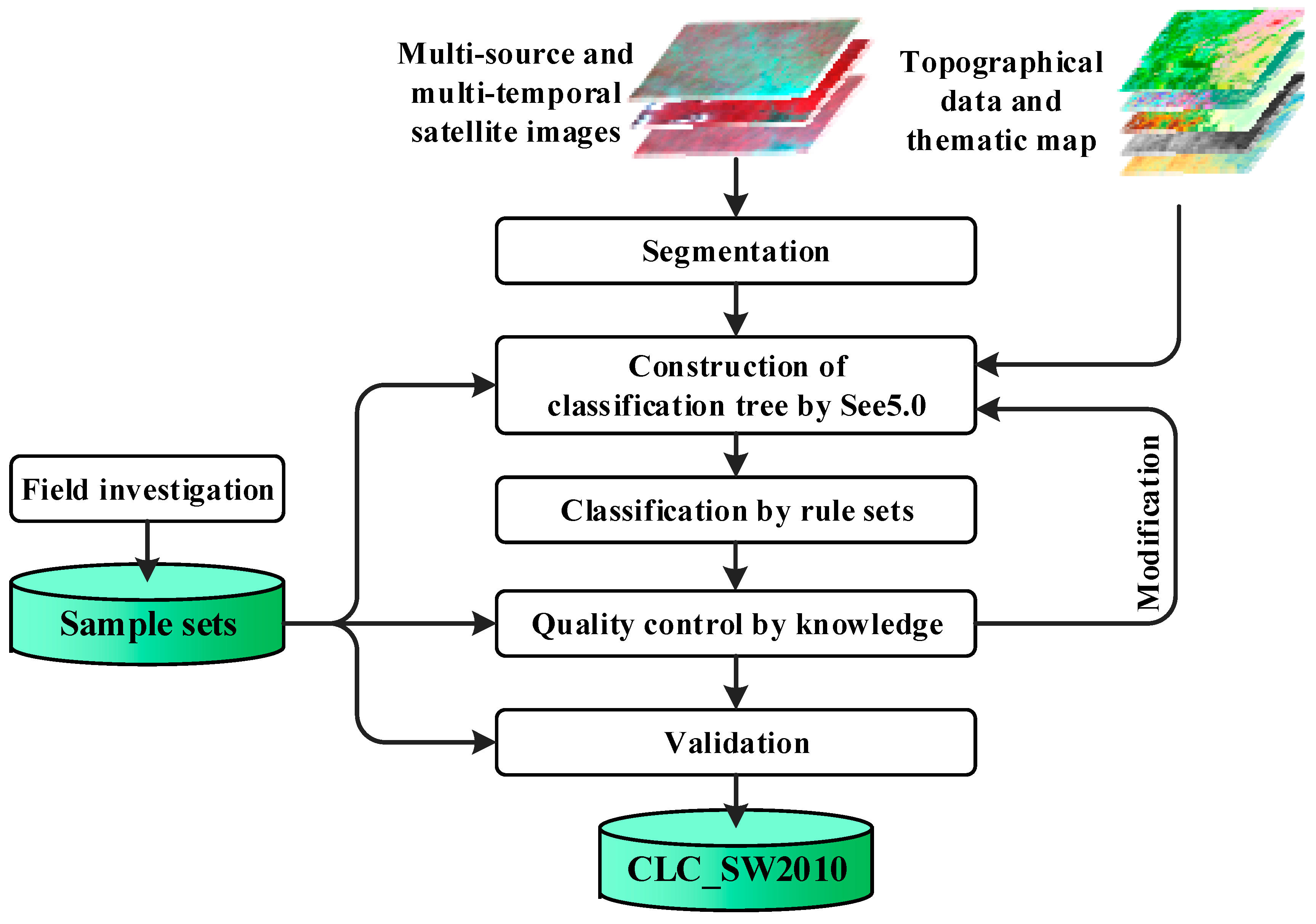
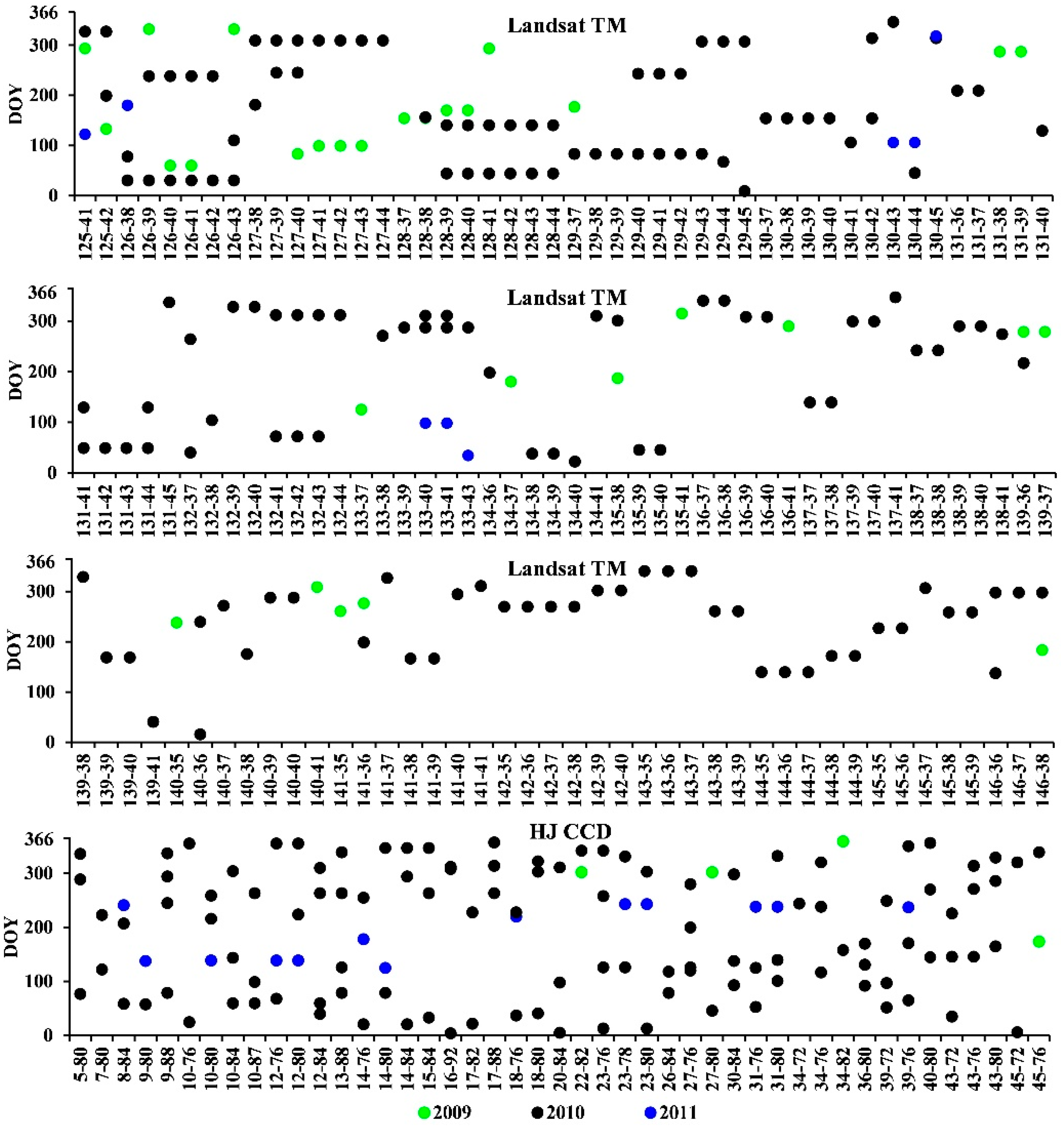
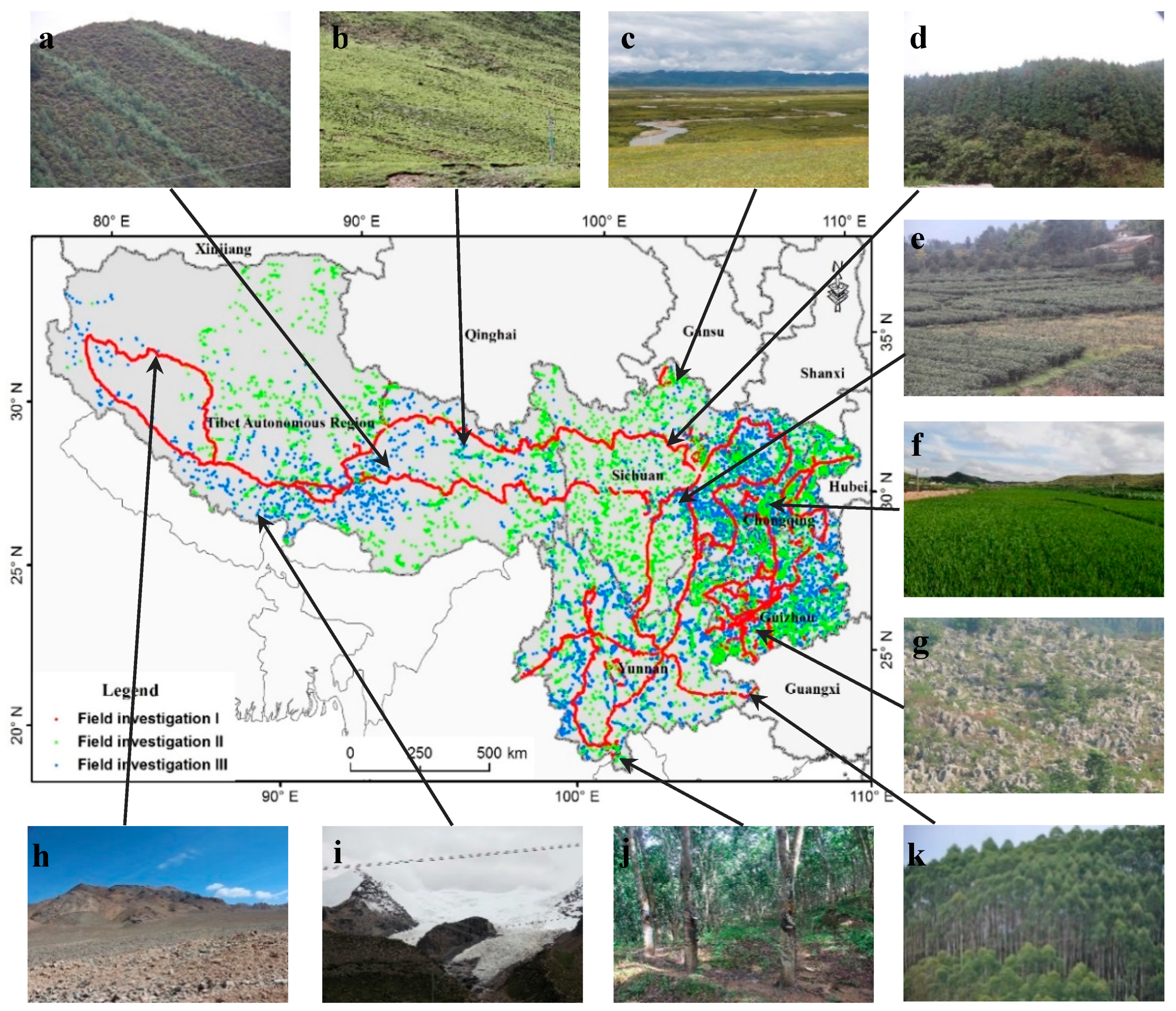
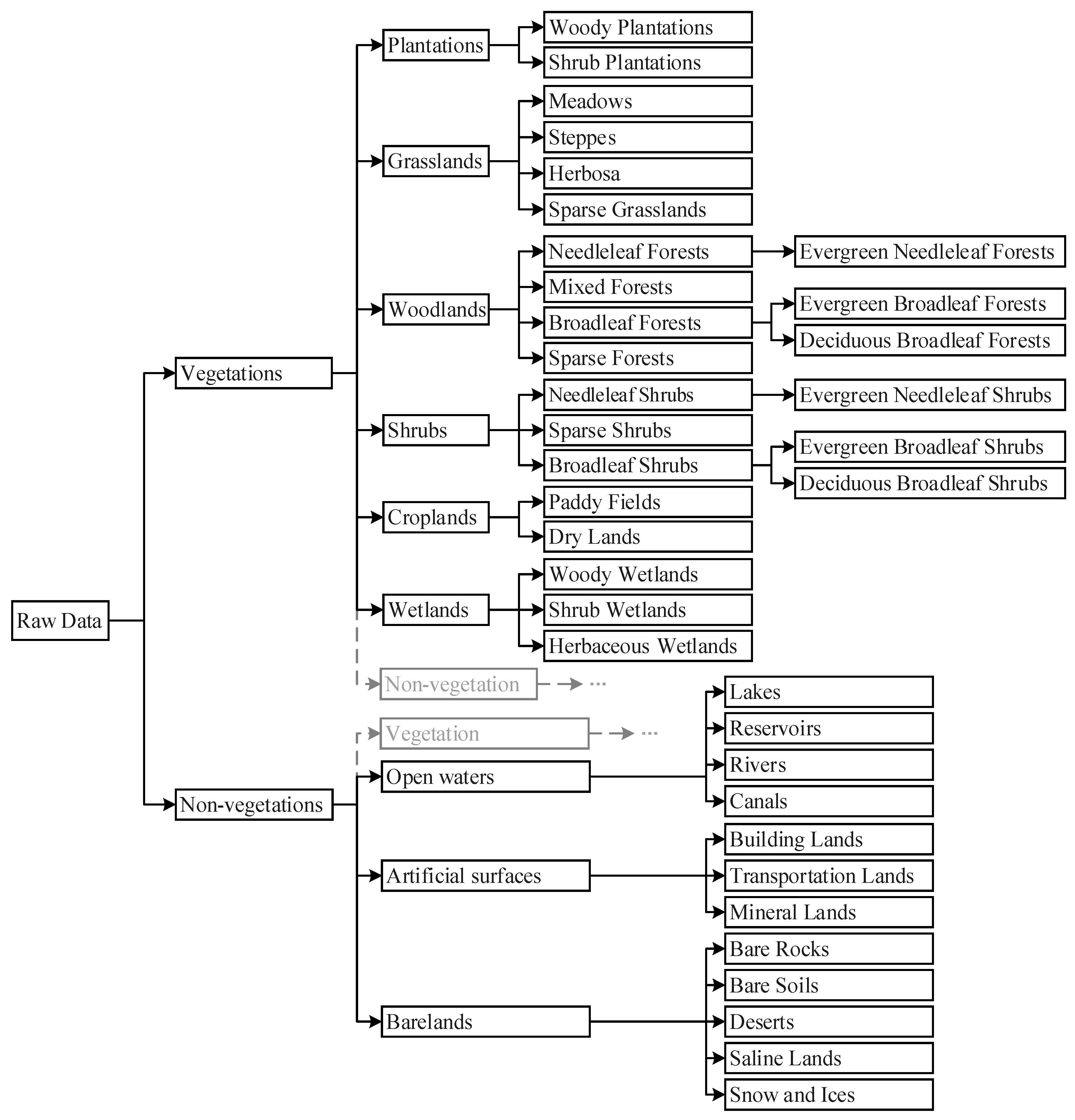
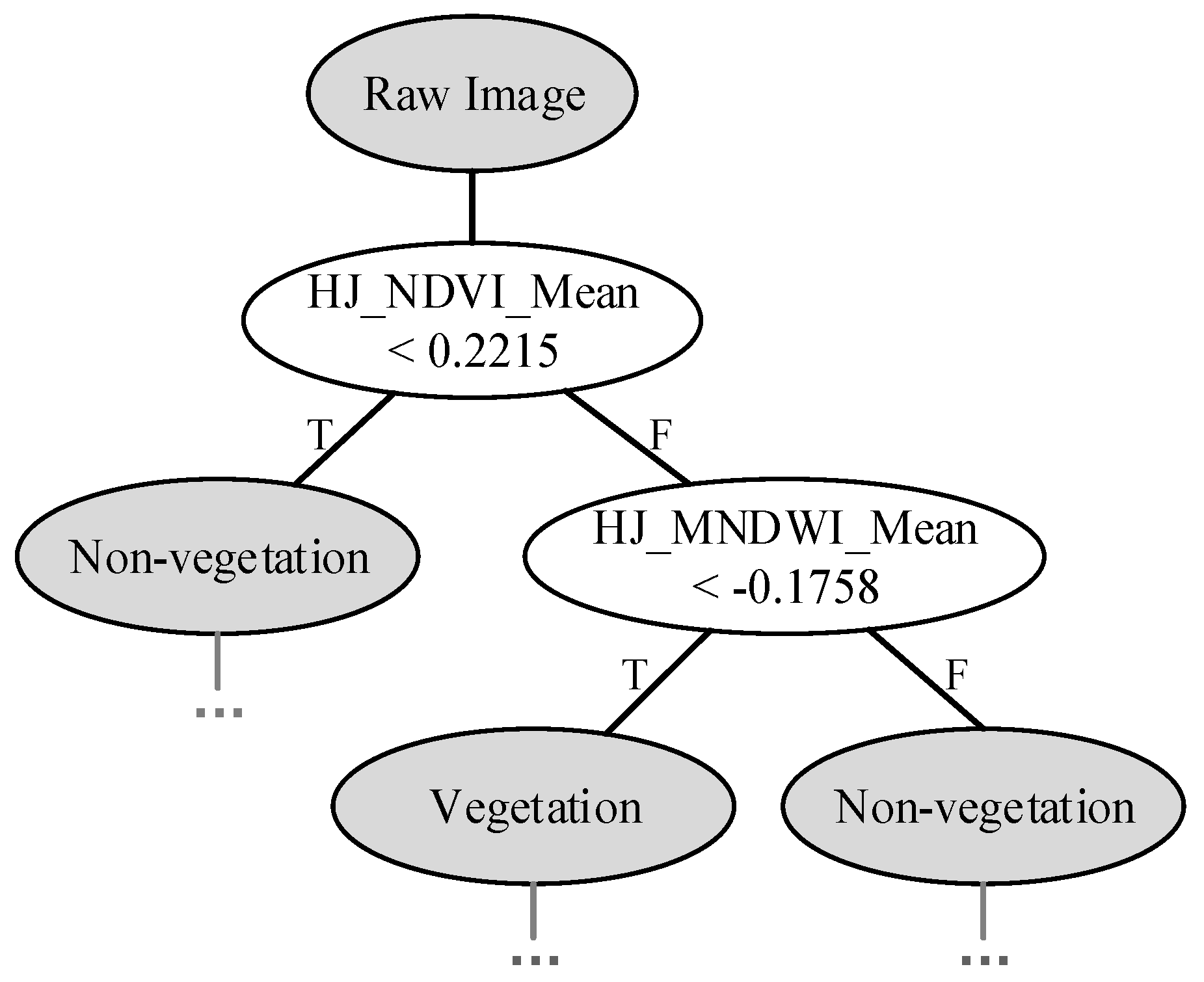
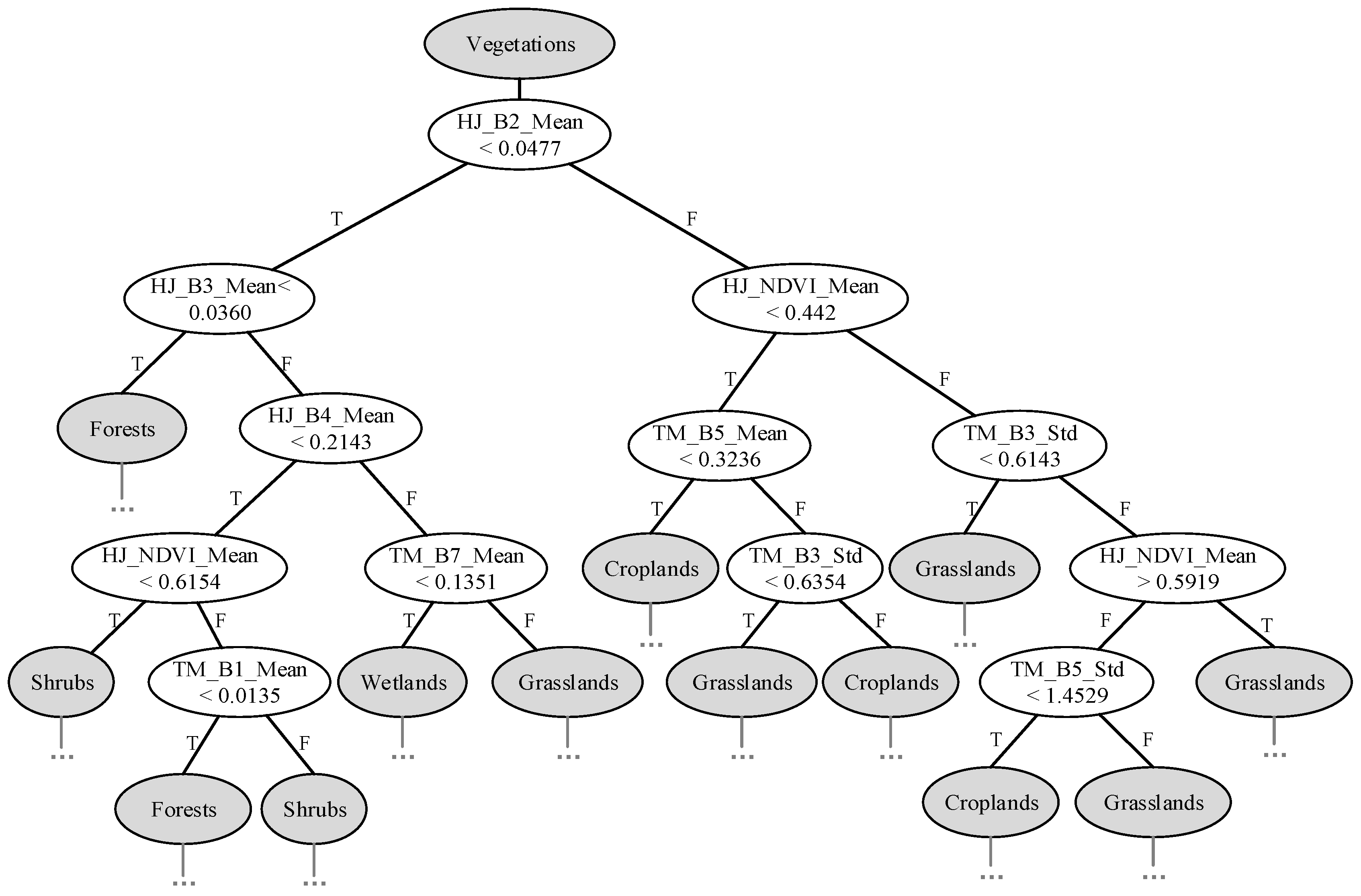
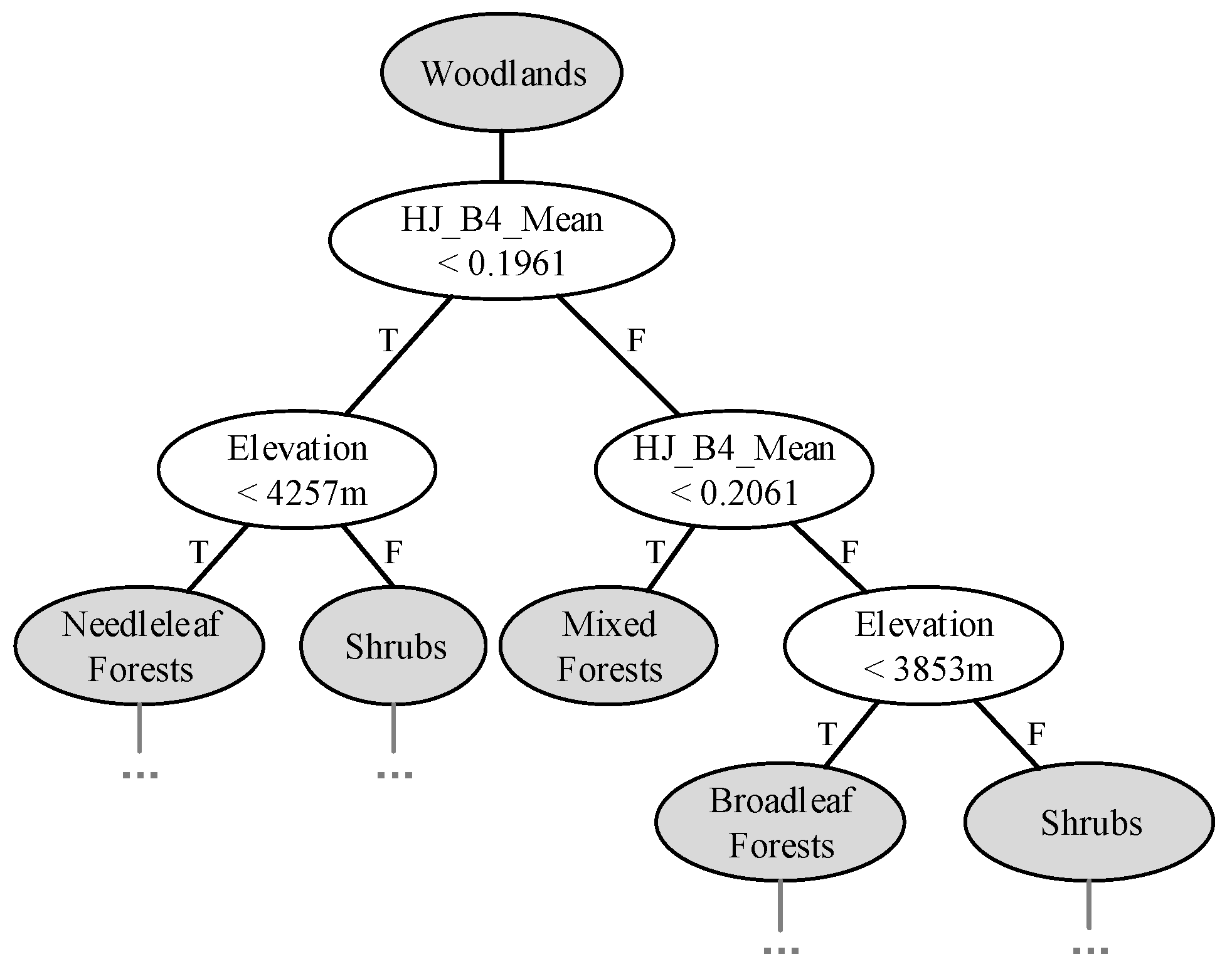
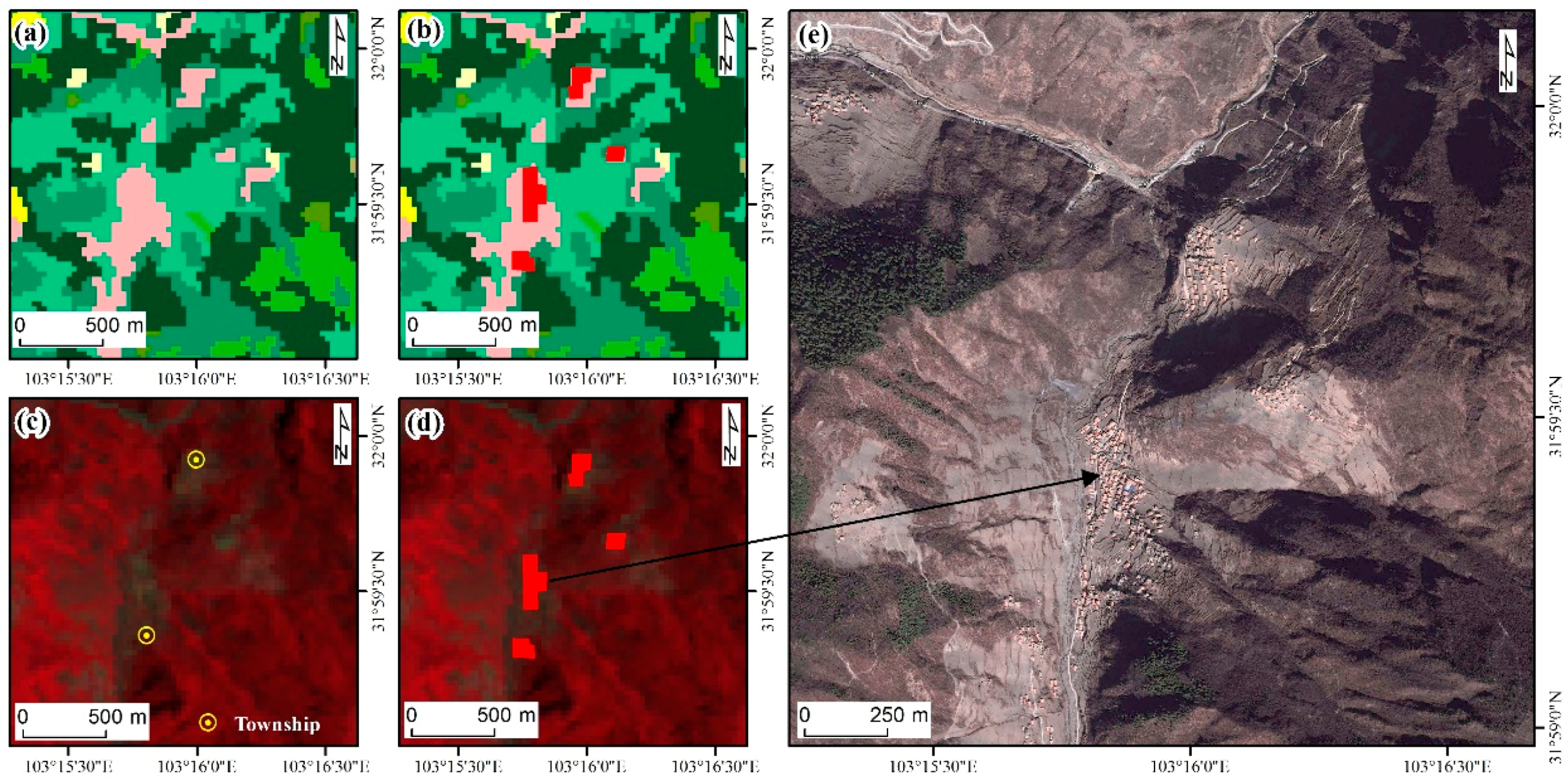
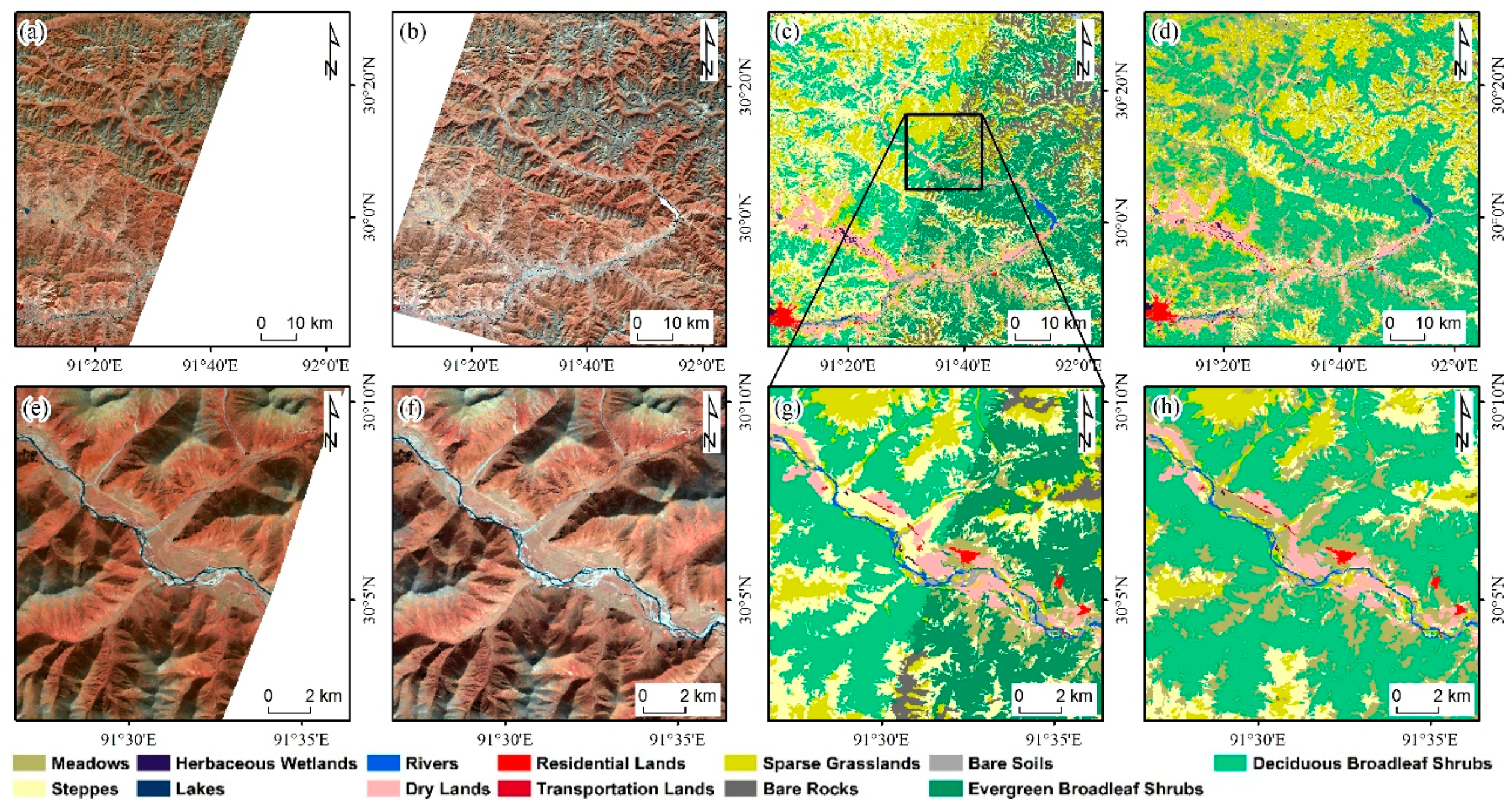
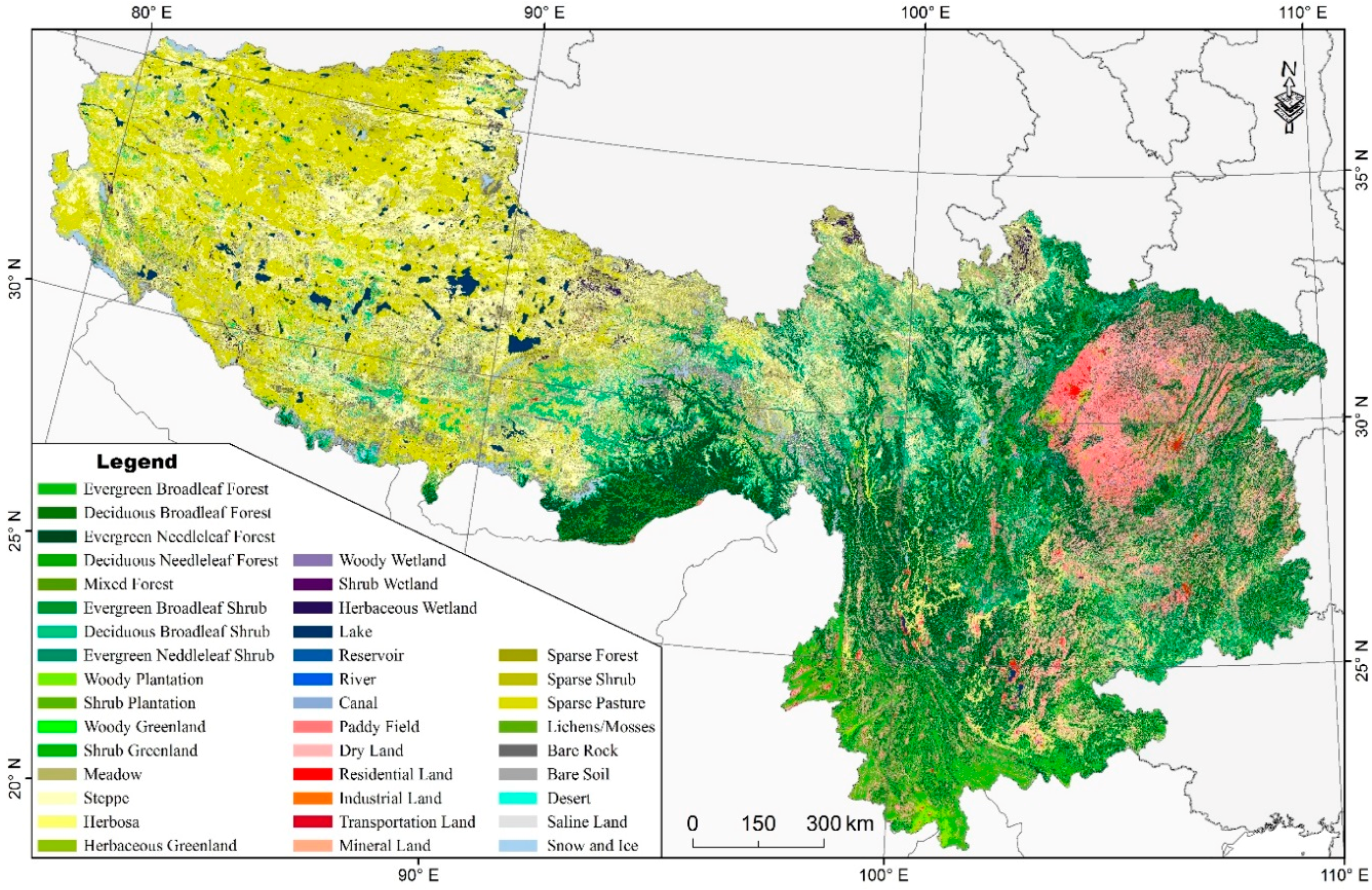
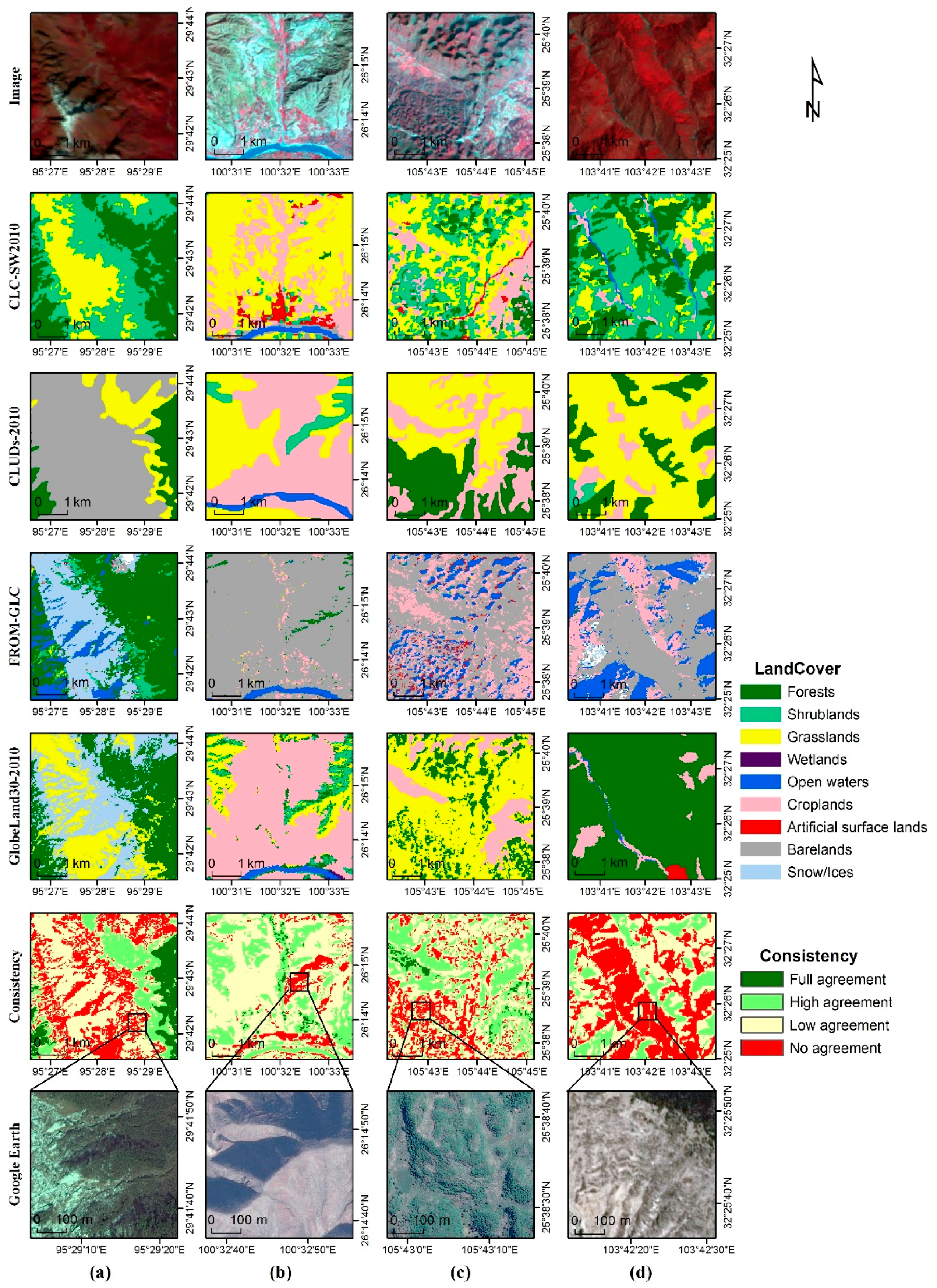
| Code I | Category I | Code II | Category II | Code I | Category I | Code II | Category II |
|---|---|---|---|---|---|---|---|
| 1 | Woodlands | 101 | Evergreen Broadleaf Forests | 3 | Wetlands | 34 | Lakes |
| 102 | Deciduous Broadleaf Forests | 35 | Reservoirs | ||||
| 103 | Evergreen Needleleaf Forests | 36 | Rivers | ||||
| 104 | Deciduous Needleleaf Forests | 37 | Canals | ||||
| 105 | Mixed Forests | 4 | Croplands | 41 | Paddy Fields | ||
| 106 | Evergreen Broadleaf Shrubs | 42 | Dry Lands | ||||
| 107 | Deciduous Broadleaf Shrubs | 5 | Artificial Surface Lands | 51 | Residential Lands | ||
| 108 | Evergreen Needleleaf Shrubs | 52 | Industrial Lands | ||||
| 109 | Woody Plantations | 53 | Transportation Lands | ||||
| 110 | Shrub Plantations | 54 | Mineral Land | ||||
| 111 | Woody Greenland | 6 | Bare Lands | 61 | Sparse Forests | ||
| 112 | Shrub Greenland | 62 | Sparse Shrubs | ||||
| 2 | Grasslands | 21 | Meadows | 63 | Sparse Grasslands | ||
| 22 | Steppes | 64 | Lichens/Mosses | ||||
| 23 | Herbosa | 65 | Bare Rocks | ||||
| 24 | Herbaceous Greenland | 66 | Bare Soils | ||||
| 3 | Wetlands | 31 | Woody Wetlands | 67 | Deserts | ||
| 32 | Shrub Wetlands | 68 | Saline Lands | ||||
| 33 | Herbaceous Wetlands | 69 | Permanent Snow and Ices |
| Types | Features | Calculation Method |
|---|---|---|
| Spectral features | The mean value of each band | |
| The standard deviation of each band | ||
| Brightness | Brightness = (b1 + b2 + b3 + b4)/4 [44] | |
| NDVI | NDVI = (b4 − b3)/(b4 + b3) [45] | |
| MNDWI | MNDWI = (b2 − b5)/(b2 + b5) [42] | |
| NDBI | NDBI = (b5 − b4)/(b5 + b4) [43] | |
| Topographic features | Elevation | |
| Slope | ||
| Aspect | ||
| Texture features | GLCM-mean | Calculated in the eCognition 8.7 platform [44] |
| GLCM-standard deviation | ||
| GLCM-entropy | ||
| GLCM-contrast | ||
| Shape features | Shape index (SI) | SI = bv/pv [44] |
| Length/Width |
| Types | Detailed Description |
|---|---|
| Single-temporal rules | Open waters and wetlands reside in a relatively flat or low relief areas |
| The spatial distribution of each forest class commonly below the tree line | |
| The spatial distribution of glaciers and permanent snow usually under the snow line | |
| Croplands rarely distribute in the high-elevation region, such as above 4000 m | |
| Paddy fields locate close to the water source and relatively flat areas | |
| Multi-temporal rules | The deciduous vegetation has obvious different spectral characteristics between leaf-on and leaf-off season, but the evergreen vegetation does not have this differences |
| Open waters have great fluctuations in rainy season, the boundary of open water is the maximum boundary in rainy season | |
| Snow and ices have great fluctuation in winter, the boundary of ice and permanent snow is the minimum boundary in summer |
| Reference | Classification | Total | Producer’s Accuracy (%) | |||||
|---|---|---|---|---|---|---|---|---|
| 1 | 2 | 3 | 4 | 5 | 6 | |||
| 1 | 2204 | 64 | 1 | 50 | 2 | 1 | 2322 | 94.92 |
| 2 | 42 | 744 | 2 | 27 | 1 | 816 | 91.18 | |
| 3 | 6 | 665 | 1 | 672 | 98.96 | |||
| 4 | 35 | 13 | 3 | 1349 | 8 | 1 | 1409 | 95.74 |
| 5 | 7 | 3 | 1 | 20 | 474 | 505 | 93.86 | |
| 6 | 1 | 2 | 197 | 200 | 98.50 | |||
| Total | 2294 | 824 | 673 | 1449 | 484 | 200 | 5924 | |
| User’s accuracy (%) | 96.08 | 90.29 | 98.81 | 93.10 | 97.93 | 98.50 | ||
| Overall accuracy: 95.09%; Kappa coefficient: 0.9345 | ||||||||
| Code | Area Ratio | Number of Samples | Producer’s Accuracy | User’s Accuracy | Code | Area Ratio | Number of Samples | Producer’s Accuracy | User’s Accuracy |
|---|---|---|---|---|---|---|---|---|---|
| 101 | 5.30% | 347 | 83.29% | 88.38% | 35 | 0.14% | 142 | 95.77% | 95.77% |
| 102 | 0.80% | 127 | 79.53% | 82.11% | 36 | 0.38% | 195 | 95.90% | 95.90% |
| 103 | 15.49% | 1303 | 90.82% | 91.89% | 37 | 0.00% | 2 | 100.00% | 100.00% |
| 105 | 0.43% | 36 | 66.67% | 75.00% | 41 | 2.64% | 508 | 92.72% | 91.99% |
| 106 | 4.38% | 266 | 81.20% | 77.42% | 42 | 7.81% | 785 | 89.68% | 88.33% |
| 107 | 6.60% | 243 | 75.72% | 65.25% | 51 | 0.47% | 356 | 93.26% | 94.05% |
| 109 | 0.44% | 74 | 87.84% | 86.67% | 52 | 0.01% | 68 | 79.41% | 87.10% |
| 110 | 1.09% | 42 | 85.71% | 76.60% | 53 | 0.06% | 48 | 87.50% | 93.33% |
| 111 | 0.01% | 3 | 100.00% | 100.00% | 54 | 0.01% | 29 | 65.52% | 95.00% |
| 21 | 6.42% | 316 | 73.42% | 87.55% | 63 | 17.39% | 111 | 77.48% | 67.19% |
| 22 | 17.84% | 217 | 62.21% | 62.50% | 65 | 2.03% | 68 | 89.71% | 98.39% |
| 23 | 3.86% | 173 | 84.39% | 71.92% | 66 | 2.42% | 60 | 91.67% | 88.71% |
| 33 | 1.03% | 117 | 99.15% | 97.48% | 68 | 0.18% | 4 | 100.00% | 57.14% |
| 34 | 1.41% | 216 | 99.54% | 100.00% | 69 | 1.32% | 68 | 100.00% | 98.55% |
| Overall accuracy: 87.14%; Kappa coefficient: 0.8573 | |||||||||
© 2016 by the authors; licensee MDPI, Basel, Switzerland. This article is an open access article distributed under the terms and conditions of the Creative Commons by Attribution (CC-BY) license (http://creativecommons.org/licenses/by/4.0/).
Share and Cite
Lei, G.; Li, A.; Bian, J.; Zhang, Z.; Jin, H.; Nan, X.; Zhao, W.; Wang, J.; Cao, X.; Tan, J.; et al. Land Cover Mapping in Southwestern China Using the HC-MMK Approach. Remote Sens. 2016, 8, 305. https://doi.org/10.3390/rs8040305
Lei G, Li A, Bian J, Zhang Z, Jin H, Nan X, Zhao W, Wang J, Cao X, Tan J, et al. Land Cover Mapping in Southwestern China Using the HC-MMK Approach. Remote Sensing. 2016; 8(4):305. https://doi.org/10.3390/rs8040305
Chicago/Turabian StyleLei, Guangbin, Ainong Li, Jinhu Bian, Zhengjian Zhang, Huaan Jin, Xi Nan, Wei Zhao, Jiyan Wang, Xiaomin Cao, Jianbo Tan, and et al. 2016. "Land Cover Mapping in Southwestern China Using the HC-MMK Approach" Remote Sensing 8, no. 4: 305. https://doi.org/10.3390/rs8040305
APA StyleLei, G., Li, A., Bian, J., Zhang, Z., Jin, H., Nan, X., Zhao, W., Wang, J., Cao, X., Tan, J., Liu, Q., Yu, H., Yang, G., & Feng, W. (2016). Land Cover Mapping in Southwestern China Using the HC-MMK Approach. Remote Sensing, 8(4), 305. https://doi.org/10.3390/rs8040305











